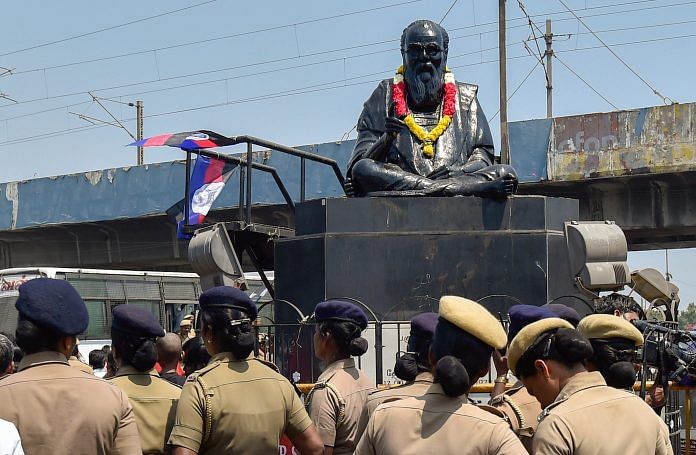After he quit Congress, Periyar joined the Justice Party that was later named Dravidar Kazhagam; he was associated with the Self-Respect Movement.
The statue of social reformer E.V. Ramasamy ‘Periyar’ was recently vandalised in Tamil Nadu’s Vellore by two inebriated men. This happened hours after BJP leader H. Raja posted a Facebook status, celebrating the razing of the Lenin statue in Tripura while warning that Periyar’s would be next in Tamil Nadu.
Who was Periyar?
Erode Venkata Ramasamy was a social activist and politician who was born in 1879 in the erstwhile Madras Presidency. He took the political plunge by joining the Congress party in his home town, Erode. It was during this time that he made efforts to eliminate caste-based discrimination. He also fought with Gandhi against providing separate dining rooms for Brahmin and non-Brahmin students in a school run by the Congress before resigning from the party in 1925.
Periyar became an icon for lower castes’ protest against Brahminical oppression after he participated in the Vaikom Satyagraha of 1924, a mass movement that demanded that lower caste be given access to the public path in front of Vaikom temple. He came to be known as Vaikom Veerar (Vaikom hero) since then.
After he quit Congress, he joined the Justice Party (later named Dravidar Kazhagam in 1944) and became a key leader in the Self-Respect Movement, which stood against Brahminical dominance.
What did he stand for?
Periyar stood by the principles of rationalism, self-respect and equality. He carved out an ideology for himself that many citizens of Tamil Nadu still swear by.
Periyar fought against inequalities among genders, caste and cultures. He was a rationalist who encouraged people to give up their caste identities by dropping suffixes in their names. His movement against assertion of Hindi in Tamil Nadu fuelled the linguistic pride among Tamilians which still continues to thrive today.
He was skeptical of Hinduism and believed that religions like Christianity and Islam provided means for the lower castes to escape the oppressive caste system. Thus, he also led a movement that destroyed Hindu idols.
He was vocal about the rights of women and actively fought for their inclusion in work force. Periyar became a father figure in Tamil Nadu and his followers later floated influential political parties such as DMK and AIADMK.
Is he relevant today?
Periyar is not only an icon for caste struggles that still exist in the country, but he is also the symbol of the Tamil pride. His ideas and work continue to hold significance for many even 45 years after his death. His legacy serves as a reminder for all political parties in Tamil Nadu to be caste conscious and live up to his ideals.







good piece
From news paper reports that using Periyar, the Dravidian parties have created an artificial North South divide and got embroiled in numerous corruption cases. That is the current legacy of Periyar.